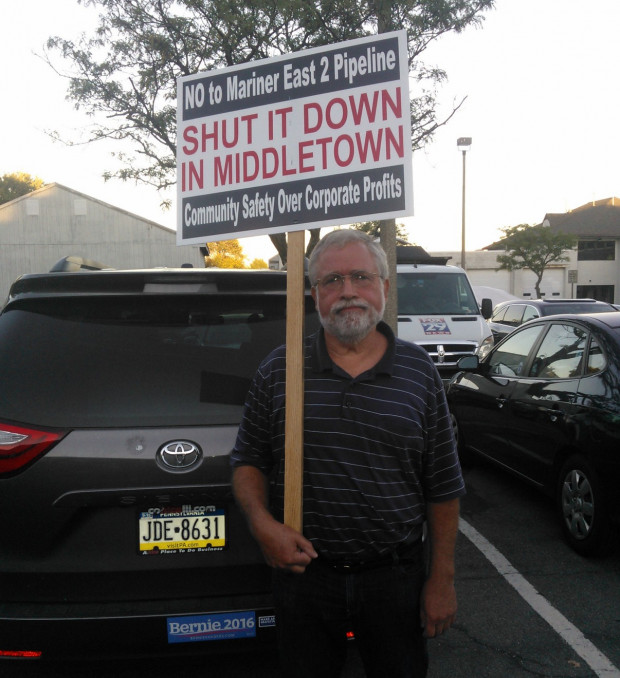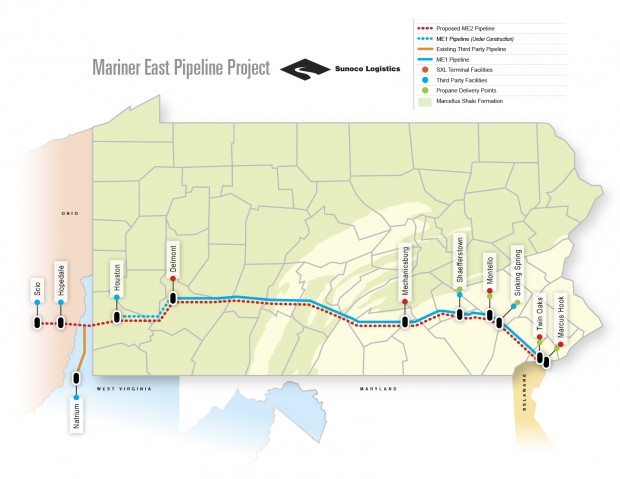Town declarations highlight public-safety worries over Mariner East 2
-
Jon Hurdle

Jon Hurdle / StateImpact PA
Mitch Trembicki, an opponent of the Mariner East 2 pipeline project, had urged Middletown officials to block a plan to build two pipelines on public land. Middletown is one of several communities along the eastern edge of the pipeline’s route to pass resolutions questioning Sunoco’s safety record.
Some communities in Philadelphia’s western suburbs are reflecting public concerns over the proposed Mariner East 2 natural gas liquids pipeline by issuing official statements saying that the $2.5 billion line could endanger public safety.
Eight townships or boroughs along or close to the route in Delaware and Chester Counties have published resolutions or proclamations as recently as December saying their residents would be vulnerable to releases of toxic and flammable gases if there was a leak or explosion.
The documents accuse the pipeline’s builder, Sunoco Logistics, of having a poor safety record, with 263 spills of hazardous liquids since 2006, the most of any company monitored by the federal Pipeline and Hazardous Materials Safety Administration.
They call for incident-response plans to be drawn up, and say local representatives should be allowed to participate in decisions by regulatory agencies on whether to allow construction of the pipeline. Some argue that a loss of local control violates a right to clean air and water under the Pennsylvania constitution.
“The Mariner East project has the potential to jeopardize public safety … by construction methods, accidental leaks, explosions or fire,” said a Dec. 19 proclamation by Delaware County’s Edgmont Township, the most recent to express its concerns.
The others are West Goshen, Thornbury, Middletown, Westtown, Rose Valley, Swarthmore and Media.
In combination, the initiatives appear to represent more advanced resistance to the pipeline plans than on any other part of the route across the state.
Alex Bomstein, a lawyer with the environmental group Clean Air Council, said that while there are other local campaign such as those in Lebanon and Huntingdon Counties, the efforts in Delaware and Chester Counties are more “developed” in the Philadelphia suburbs.
“There are more people organizing than elsewhere,” he said, probably because of a greater population density closer to Philadelphia.
Responding to the statements, Sunoco reiterated its assurances that there are multiple safety provisions built into its plans to build the 350-mile pipeline from the Marcellus Shale of western Pennsylvania to a processing and exporting facility at the Marcus Hook Industrial Complex near Philadelphia.
Company spokesman Jeff Shields said Mariner East 2 will meet the same safety standards as the existing Mariner East 1 line which he said was endorsed by Accufacts, an independent consultant, in its March 2016 evaluation of Sunoco’s plan to repurpose the line. The consultant said the Mariner East 1 project exceeded federal government safety standards.
“There are many layers of safety in place to prevent a major incident including additional safety standards in populated areas,” Shields said.
He noted that pipeline safety is regulated by the federal government and Pennsylvania’s Public Utility Commission, and that local authorities have emergency response plans to deal with facilities such as large natural gas lines. Sunoco has a tradition of educating first responders, and has done so with some 1,000 local personnel in Pennsylvania to date, Shields said.
He argued that three of the communities to publish statements – Rose Valley and Swarthmore, plus a letter of support from Media — are not on the pipeline route.

Sunoco Logistics
A map of the planned Mariner East 2 pipeline across Pennsylvania. Local communities in the southeast part of the state have expressed concerns about the company’s safety record by passing resolutions.” credit=”
But Eve Miari, a spokeswoman for the anti-pipeline Middletown Coalition for Community Safety, said some communities that are not directly on the route have issued statements because of concerns that they could be affected by escaping gas several miles away from any leak, or that water supplies could be contaminated by disturbance to streams during construction.
“The evacuation zones for these types of accidents can be three to five miles,” Miari said.
The community statements are similar to each other because of consultation between their leaders but there is no central template for the documents, she said.
The Middletown campaign was set back late last year when the town council voted to allow Sunoco to build the pipeline on four parcels of public land but called for strong protections against leaks or explosions.
Sunoco says it expects to begin construction of Mariner East 2 in “late winter or early spring” this year, and to start operations in the third quarter. But the company is still awaiting water-quality permits from the Pennsylvania Department of Environmental Protection after incomplete submissions in 2016.
The company resubmitted its applications on Dec. 5 but any more deficiencies could delay the projected startup date.
James Schmid, a consulting ecologist who has evaluated other Sunoco applications, said the company’s new proposal for ensuring water quality at one site where the pipeline would be built in Huntingdon County has not met all of the DEP’s earlier concerns.
Asked whether the company will meet its timeline, Schmid said: “That seems unlikely because Sunoco was not really responding to all of the comments from the DEP.”
Meanwhile, Schmid’s company has been hired by the Middletown group to assess how Mariner East 2 would affect water sources in Delaware County. He said the study is due to finish by the end of January.
The community statements, though just symbolic, are part of a broader campaign to encourage communities to assert more control over the oil and gas industry, said Eric Friedman, a steering committee member for the Middletown group.
Friedman argued that municipalities are required to protect the health and safety of their residents, and have the legislative and executive power to do so.
“The strategy at the municipal level is to get local governments to exercise that power by adopting zoning and land use ordinances regarding oil and gas operations,” he said. “Getting them to recognize the hazards via resolutions of concern has been a first step along that path.”
Asked whether such ordinances could be pre-empted by use of eminent domain – which is being used by Sunoco to take private land at some places along the Mariner route — Friedman predicted that local authorities’ responsibility to protect public health and safety would prevail.
Meanwhile, campaigners are asking whether the federal regulations governing the transportation of natural gas liquids are being used in a way that recognizes the partially gaseous nature of the material in a pipeline.
Lawyers representing Middletown landowners wrote to the federal Pipeline and Hazardous Materials Safety Administration in October, asking for an interpretation on whether public safety was being properly protected by 49 CFR Part 195, a rule that is the primary regulation for the NGL pipeline industry.
“We believe Part 195 is not fully protective of public safety concerning vapor phase hazards that occur during two-phase NGL transportation,” lawyer Rich Raiders wrote to PHMSA.
A spokeswoman for the agency said Wednesday a response to the Raiders letter was being “finalized” and would be sent out shortly.
















